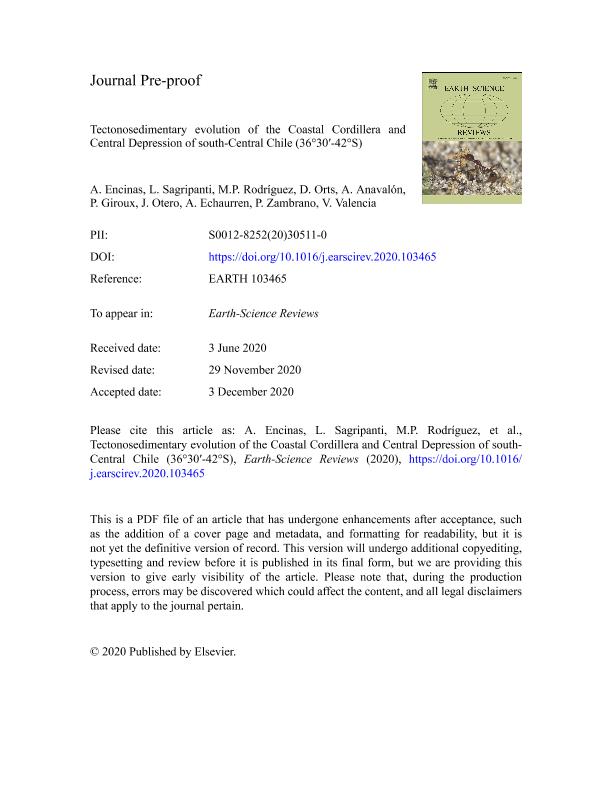Artículo
Tectonosedimentary evolution of the Coastal Cordillera and Central Depression of south-Central Chile (36°30′-42°S)
Encinas, A.; Sagripanti, Lucía ; Rodríguez, M.P.; Orts, Darío Leandro
; Rodríguez, M.P.; Orts, Darío Leandro ; Anavalón, A.; Giroux, P.; Otero, J.; Echaurren Gonzalez, Andres
; Anavalón, A.; Giroux, P.; Otero, J.; Echaurren Gonzalez, Andres ; Zambrano, P.; Valencia, V.
; Zambrano, P.; Valencia, V.
 ; Rodríguez, M.P.; Orts, Darío Leandro
; Rodríguez, M.P.; Orts, Darío Leandro ; Anavalón, A.; Giroux, P.; Otero, J.; Echaurren Gonzalez, Andres
; Anavalón, A.; Giroux, P.; Otero, J.; Echaurren Gonzalez, Andres ; Zambrano, P.; Valencia, V.
; Zambrano, P.; Valencia, V.
Fecha de publicación:
02/2021
Editorial:
Elsevier Science
Revista:
Earth-science Reviews
ISSN:
0012-8252
Idioma:
Inglés
Tipo de recurso:
Artículo publicado
Clasificación temática:
Resumen
The forearc of south-central Chile (36°30′-42°S) is characterized by the presence of a Coastal Cordillera and a low lying area known as the Central Depression. The origin of these morphostructural units has been largely debated. They have been ascribed to different ages between the Cretaceous and the Pliocene, and tectonic causes that involve extensional or contractional deformation and have been related to Andean evolution or accretionary processes in the forearc. To investigate the geologic evolution of the Coastal Cordillera and Central Depression in the cited area, we based on stratigraphy, sedimentology, geochronology (U[sbnd]Pb, LA-ICP-MS), structural geology, and geomorphology. Our studies, which are based on our own data and a thorough bibliographic review, indicate the following sequence of events in the tectono-sedimentary evolution of the forearc of south-central Chile during the late Cenozoic. The area was subjected to extensional tectonics caused by slab rollback during the Oligocene-early Miocene, resulting in the genesis of a series of basins filled with volcanic, continental, and marine deposits that extended from the present Chilean coast to the retroac. The extensional basins were tectonically inverted during the late Early-Late Miocene, and most of the forearc became a positive relief that was subjected to fluvial erosion. The West Andean Thrust, a major reverse west verging fault in the limit between the Central Depression and the Andean Cordillera, caused significant uplift of the western flank of the Andes. This triggered flexural subsidence and the accumulation of coarse-grained deposits in the forearc during the Pliocene-Pleistocene. The sudden increase of sediment flux to the trench during this period caused a change from non-accretion or subduction erosion to accretion in the margin of south-central Chile. Progressive growth of the accretionary wedge gave birth to a forearc high, the Coastal Cordillera, which was uplifted in the last 2 Ma. Some forearc areas placed above subducted oceanic fracture zones did not experience uplift during this period due to the significant transport of fluid that inhibited the deformation of the accretionary wedge. Our studies show that the late Cenozoic tectono-sedimentary evolution of the forearc in the study area is complex and involves different processes related to Andean evolution in the first stage and accretionary processes acting exclusively in the forearc in a second stage. The Coastal Cordillera and the Central Depression of south-central Chile were developed in the last 2 Ma and are much younger than classically considered.
Archivos asociados
Licencia
Identificadores
Colecciones
Articulos(IIPG)
Articulos de INSTITUTO DE INVESTIGACION EN PALEOBIOLOGIA Y GEOLOGIA
Articulos de INSTITUTO DE INVESTIGACION EN PALEOBIOLOGIA Y GEOLOGIA
Citación
Encinas, A.; Sagripanti, Lucía; Rodríguez, M.P.; Orts, Darío Leandro; Anavalón, A.; et al.; Tectonosedimentary evolution of the Coastal Cordillera and Central Depression of south-Central Chile (36°30′-42°S); Elsevier Science; Earth-science Reviews; 213; 2-2021
Compartir
Altmétricas



